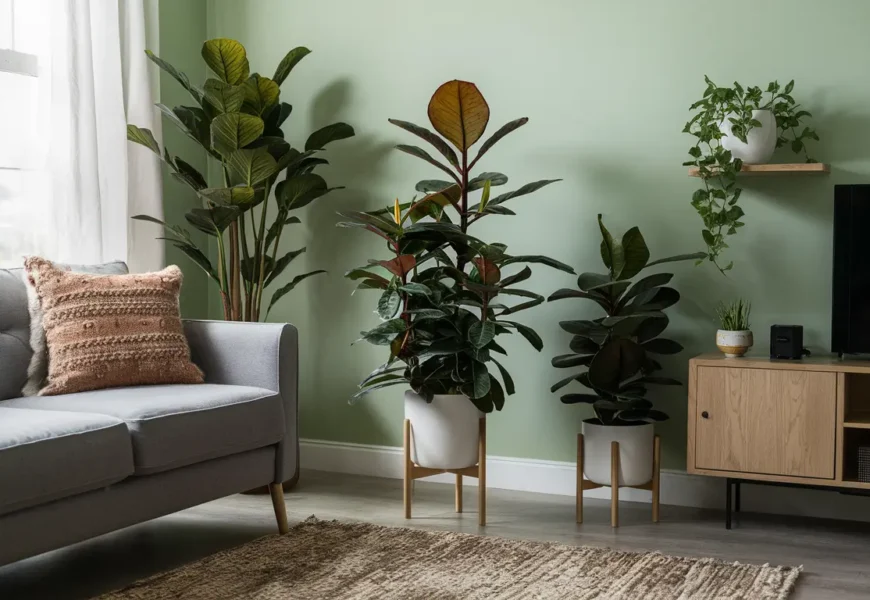Welcome to the fascinating world of ZZ plants! If you’ve ever marveled at the strength and beauty of indoor plants, you’re in for a treat. In this guide, we’ll delve into the remarkable qualities of ZZ plants, those resilient green companions that effortlessly add charm to any space. Prepare to be amazed as we uncover the secrets behind the incredible strength and beauty of ZZ plants.
Table of Contents
- Introduction to ZZ Plants
- Unveiling the Wonders of ZZ Plants
- Resilience: Thriving Against the Odds
- Drought Tolerance: Surviving Dry Spells
- Adaptability to Low Light: Bringing Greenery to Every Corner
- Mastering ZZ Plant Care
- Watering Sparingly: The Secret to Thriving
- Ideal Light Conditions: Making the Most of Any Space
- Pest and Disease Management: Keeping ZZs Healthy and Happy
- Conclusion: Embracing the Amazing Strength of ZZ Plants
Are you ready to embark on an exciting journey into the world of ZZ plants? Let’s dive in and discover just how amazing and strong these resilient green wonders truly are.
Unveiling the Wonders of ZZ Plants
Resilience: Thriving Against the Odds
- Tough Survivors: ZZ plants are renowned for their ability to thrive even when neglected. They can endure periods of forgetfulness when it comes to watering, making them perfect for busy individuals or those who may not have a green thumb.
- Adaptable to Various Environments: Whether your home receives plenty of natural light or is bathed in shade, ZZ plants can adapt and thrive in a wide range of environmental conditions. They’re like the chameleons of the plant world, effortlessly blending into any space.
- Surviving Tough Conditions: Even in less-than-ideal conditions, such as dry air or fluctuating temperatures, ZZ plants soldier on, displaying their lush green foliage as a testament to their resilience.
Related Post: Have you ever wondered how ZZ plants manage to thrive in such diverse environments? Check out this post on the science behind self-watering planters, which can help ZZ plants maintain their resilience.
Drought Tolerance: Surviving Dry Spells
- Water-wise Warriors: ZZ plants have evolved to survive drought conditions, thanks to their succulent-like rhizomes. These underground stems store water, allowing ZZ plants to go for extended periods without a drink.
- Minimal Water Requirements: Unlike many other houseplants that require frequent watering, ZZ plants prefer to be watered sparingly. In fact, overwatering can be more detrimental to their health than underwatering, so it’s best to err on the side of caution.
- Perfect for Forgetful Waterers: If you tend to forget to water your plants regularly, ZZ plants are your perfect match. Their ability to tolerate dry spells makes them low-maintenance companions that can thrive with minimal intervention.
Related Post: Curious about the best watering practices for ZZ plants? Learn more about watering ZZ plants sparingly to ensure their long-term health and vitality.
Adaptability to Low Light: Bringing Greenery to Every Corner
- Thriving in Dim Conditions: ZZ plants are champions when it comes to low-light environments. Whether placed in a dimly lit corner or a room with minimal natural light, ZZ plants will continue to grow and thrive.
- Ideal for Offices and Apartments: If you work in an office with limited sunlight or live in an apartment with shaded windows, ZZ plants are the perfect solution. They bring a touch of greenery to spaces that may not receive ample sunlight, brightening up the atmosphere.
- Versatile Placement Options: With their adaptability to low light, ZZ plants can be placed virtually anywhere indoors. From bathrooms to basements, bedrooms to boardrooms, there’s no space that ZZ plants can’t enhance with their lush foliage.
Related Post: Looking for ways to brighten up a dimly lit room? Discover the top plants for low-light conditions and how ZZ plants can thrive in such environments.
Mastering ZZ Plant Care
Watering Sparingly: The Secret to Thriving
- Less is More: ZZ plants prefer to be watered sparingly, allowing their soil to dry out between waterings. Overwatering can lead to root rot and other issues, so it’s important to exercise restraint when watering your ZZ plant.
- Check Before Watering: Before reaching for the watering can, always check the soil moisture level. Stick your finger about an inch into the soil—if it feels dry, it’s time to water. If it’s still moist, hold off for a few more days.
- Use Well-draining Soil: Opt for a well-draining potting mix to prevent water from pooling around the roots. This helps mimic the ZZ plant’s natural habitat, where water drains away quickly after rain showers.
Related Post: Learn more about the importance of watering ZZ plants sparingly and how to avoid common watering mistakes by checking out this guide to essential growth factors for indoor plants.
Ideal Light Conditions: Making the Most of Any Space
- Bright, Indirect Light: While ZZ plants can tolerate low light, they thrive best in bright, indirect sunlight. Place your ZZ plant near a window where it can enjoy plenty of natural light without being exposed to direct sunbeams, which can scorch its leaves.
- Rotate Regularly: To ensure even growth and prevent your ZZ plant from leaning towards the light source, rotate it every few weeks. This helps promote balanced growth and keeps your plant looking its best.
- Supplemental Lighting: If you’re unable to provide sufficient natural light, consider supplementing with artificial grow lights. LED grow lights are an excellent option for providing the right spectrum of light for ZZ plants without producing excessive heat.
Related Post: Discover how the right blinds can enhance your indoor gardening experience by reading this post on choosing the best blinds for thriving houseplants.
Pest and Disease Management: Keeping ZZs Healthy and Happy
- Watch for Pests: While ZZ plants are generally pest-resistant, they can still fall victim to common houseplant pests like spider mites and mealybugs. Keep an eye out for signs of infestation, such as webbing or sticky residue on the leaves.
- Natural Remedies: If you do encounter pests, try using natural remedies like neem oil or insecticidal soap to control the infestation. These methods are effective at killing pests while being safe for your ZZ plant and the environment.
- Preventive Measures: To minimize the risk of pests and diseases, practice good plant hygiene. Remove any dead or yellowing leaves, and regularly inspect your ZZ plant for signs of stress or illness.
Related Post: Learn how to keep your ZZ plants safe from curious pets by reading this post on stopping pets from digging in houseplants.
Conclusion: Embracing the Amazing Strength of ZZ Plants
As we come to the end of our journey through the world of ZZ plants, it’s clear to see why these remarkable green companions have captured the hearts of indoor gardeners everywhere. From their resilience in the face of neglect to their ability to thrive in low-light conditions, ZZ plants truly are amazing and strong in every sense of the word.
Recap of Key Points:
- Resilience: ZZ plants can thrive even when neglected and are adaptable to a wide range of environmental conditions.
- Drought Tolerance: With their succulent-like rhizomes, ZZ plants can survive extended periods without water, making them perfect for forgetful waterers.
- Adaptability to Low Light: ZZ plants can flourish in dimly lit environments, bringing greenery to every corner of your home or office.
Next Steps:
Now that you’re armed with the knowledge to care for ZZ plants like a pro, why not add one to your indoor garden? Whether you’re a seasoned plant parent or just starting your green journey, ZZ plants are sure to delight with their enduring charm and beauty.
Related Post: Ready to bring home your own ZZ plant? Check out this guide to DIY garden projects for tight budgets, and get inspired to create a beautiful indoor oasis.
So go ahead, embrace the amazing strength of ZZ plants, and watch as they transform your space into a lush and vibrant sanctuary of greenery. Happy gardening!
FAQ
How often should I water my ZZ plant?
For ZZ plants, less is more when it comes to watering. It’s best to water sparingly and allow the soil to dry out between waterings. Stick your finger about an inch into the soil—if it feels dry, it’s time to water. Typically, ZZ plants need water every two to three weeks, but this can vary depending on factors like temperature, humidity, and light conditions.
Can ZZ plants survive in low-light conditions?
Yes, ZZ plants are champions when it comes to low-light environments. While they prefer bright, indirect sunlight, they can thrive in dimly lit spaces where other plants struggle to survive. ZZ plants are perfect for offices, bathrooms, and other areas with limited natural light.
How do I prevent pests and diseases in my ZZ plant?
While ZZ plants are generally pest-resistant, they can still fall victim to common houseplant pests like spider mites and mealybugs. To prevent infestations, practice good plant hygiene by regularly inspecting your ZZ plant for signs of pests and removing any dead or yellowing leaves. If you do encounter pests, treat them with natural remedies like neem oil or insecticidal soap.
Can ZZ plants be grown outdoors?
While ZZ plants are typically grown indoors as houseplants, they can also be grown outdoors in mild climates. However, they prefer shaded or partially shaded areas with well-draining soil. If you live in a colder climate, consider bringing your ZZ plant indoors during the winter months to protect it from frost.
How do I propagate ZZ plants?
Propagating ZZ plants is relatively easy and can be done through division or leaf cuttings. To divide a ZZ plant, carefully separate the rhizomes and plant them in individual pots. For leaf cuttings, simply cut a leaf from the plant and place it in a pot with well-draining soil. Keep the soil moist and within a few weeks, you should see new growth emerging from the cutting.







